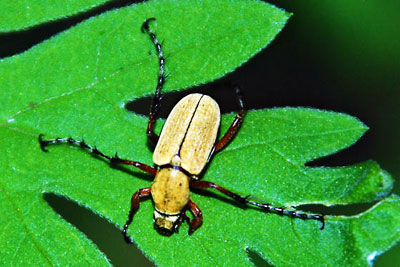Rose chafers and June go together
Sandy soils and tasty plants help define rose chafers’ habitat.
The rose chafers are coming, the rose chafers are coming, could be the call of gardeners living on sandy soils. June is usually the month when many people become aware of their presence. Or they are aware of the ragged, chewed holes in flowers, leaves and fruit. Currently in southwest Michigan, they are beginning to appear.
Rose chafers, or Macrodactylus subspinosus, are beetles with a wide geographical range and a wide range of preferred plants. For some gardeners, they could be considered the opening act for Japanese beetles that will emerge at approximately the time that rose chafers are declining. This is usually at the end of May or June. Luckily, there is only one generation of rose chafers a year. Unluckily, it is here now. Rose chafers will feed for three to four weeks as adults. The larvae or grubs spend the winter in the soil and then feed on plant and grass roots in the spring before they emerge as adults.
Rose chafers are a much more common sight on sandy soils than on clay soils. Since part of their lifecycle is below ground, it is much easier to maneuver in looser soils. These tan, slender beetles are slightly larger than 0.5 inches in length. Their thin, spiny legs have a reddish color and the undersides of their bodies are gray-black. They are noted for their voracious appetites and the way they pile onto each other in happy, tangled knots. It is mating season, after all.

Rose chafer. Photo credit: Dawn Griffith, bugguide.net
Rose chafers have broad tastes in plants. High on the list of favorites are roses, peonies, geraniums, foxgloves, hollyhocks, poppies and dahlias. They feed on flower petals and leave ragged holes that turn brown around the edges. They will eat leaves if their favorite menu items are depleted. Rose chafers are very fond of fruit, including grape leaves and small grapes, apples, cherries, peaches, strawberries, raspberries and pears. Other landscape plants to draw their attention are hydrangeas, Virginia creepers and wisterias. Vegetable gardens are not immune. Rose chafers will eat leaves on corn, beets, beans, cabbage and peppers. It would be simpler to list what they won’t eat.
There are several methods of control from “hunt and pick” to placing screen frames around prized rosebushes. It is possible to use several registered insecticides on them, but use care in choosing the correct one to use on vegetable or fruit crops.
Interesting side note: rose chafers are poisonous to birds, including chickens, so do not offer them up as a treat.



 Print
Print Email
Email